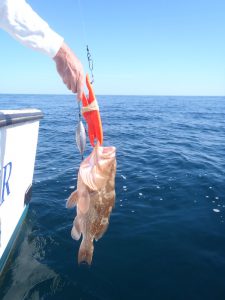Beginning July 15, 2020 all recreational, commercial, and for-hire vessels will be required to have a working descending device on-board and readily available when fishing for any of the fish in the snapper-grouper fishery management unit in federal waters of the Atlantic Ocean from North Carolina to Florida. In the Florida Keys, this means any vessel that is fishing for reef fish in the South Atlantic will be required to possess descending gear when fishing greater than 3-nautical miles offshore all the way through the Dry Tortugas. Fish may be released using a fishing pole or hand-line with a descending device attached to a minimum 16-ounce weight, or a weighted container, with at least 60 feet of line that is capable of returning fish back to a depth of at least 50 feet. The South Atlantic Fishery Management Council has examples of descending devices and a video to make your own using a weighted barbless hook at https://safmc.net/best-fishing-practices/.
 NOAA Fisheries recommends using descending devices on fish exhibiting signs of barotrauma. The new regulation does not prohibit the use of venting tools, but a descending device will still need to be on board and readily available for use. Barotrauma occurs when fish are caught and brought up from deep water, typically greater than 50 feet of depth. The rapid change in pressure when the fish is brought to the surface causes the swim bladder to expand (or even burst). Common signs of barotrauma are the stomach protruding out of the mouth, bulging eyes, and distended intestines. Descending devices use a weight to return the fish to depth, which recompresses the expanded gas and reverses the effects of barotrauma. Science has shown that descending gear is effective at getting fish back down to depth, and this increases survival rates by minimizing the effects of barotrauma.
NOAA Fisheries recommends using descending devices on fish exhibiting signs of barotrauma. The new regulation does not prohibit the use of venting tools, but a descending device will still need to be on board and readily available for use. Barotrauma occurs when fish are caught and brought up from deep water, typically greater than 50 feet of depth. The rapid change in pressure when the fish is brought to the surface causes the swim bladder to expand (or even burst). Common signs of barotrauma are the stomach protruding out of the mouth, bulging eyes, and distended intestines. Descending devices use a weight to return the fish to depth, which recompresses the expanded gas and reverses the effects of barotrauma. Science has shown that descending gear is effective at getting fish back down to depth, and this increases survival rates by minimizing the effects of barotrauma.
Reef fish like snapper and grouper are the most susceptible species to barotrauma because they live on the bottom. The snapper-grouper fishery management unit includes a large list of fish, including snappers, groupers, and popular food fish like amberjack, black seabass, spadefish, triggerfish, and tilefish. Considering that more than 60% of recreational fish are caught and released alive, use of descending gear can increase the number of fish that survive to be caught again at a larger size or later when in-season. Fisheries research conducted in collaboration with fishermen shows that using descending tools greatly increases survival rates. Another advantage is descending gear reduces depredation on “floaters,” or released fish floating on the surface. These impaired fish are often eaten by birds, dolphins, barracuda, and sharks as they struggle to return to deeper water. For more information on how to identify barotrauma and select and use descending gear, please visit the Florida Sea Grant Catch and Release website at catchandrelease.org or call the UF/IFAS Monroe County Extension at 305-292-4502.
 0
0
